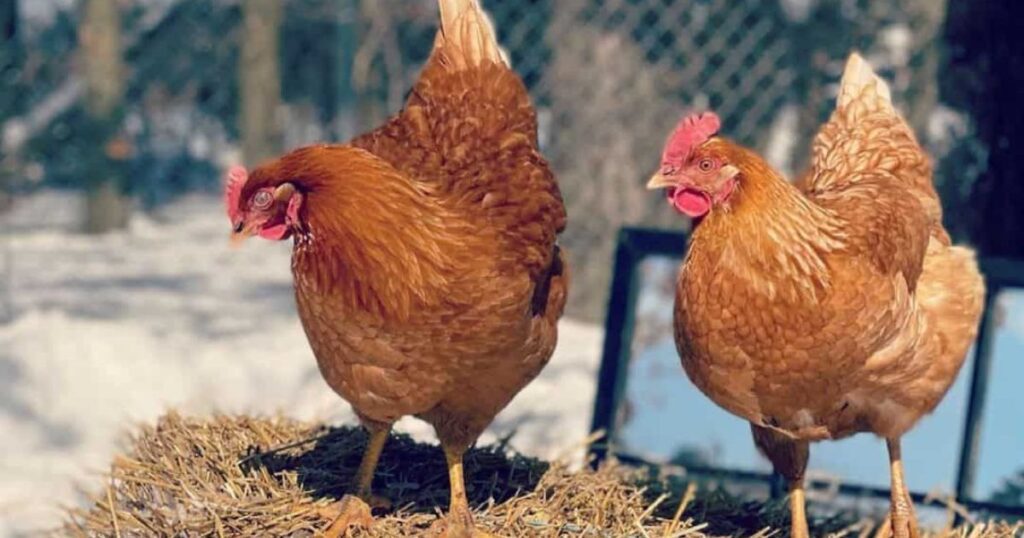If you’re seeking an abundance of large, rich brown eggs from a docile, cold-hardy breed, look no further than the Isa Brown chicken.
Renowned as the best brown egg layer worldwide, this intelligent hybrid has taken backyard and farmstead flocks by storm.
With a fascinating history, impressive production capabilities, and friendly dispositions, it’s no wonder Isa Browns are a beloved choice.
History
The Isa Brown’s unique origins trace back to 1978 in France, where they were purposefully developed by the Institut de Selection Animale (Institute for Egglayer Selection). As their name implies, Isa Browns were strategically bred to be superior egg producers.
While the parent breeds used to create this hybrid remain a closely guarded secret, many experts speculate Isa Browns are closely related to the heritage Rhode Island Red breed known for its impressive egg-laying abilities.
Heritage or Hybrid?

Unlike many popular chicken breeds with roots dating back to the 1800s, Isa Browns are a relatively new hybrid chicken breed.
As a hybrid created by crossing two distinct lines, rather than a standardized purebred, they have not yet been accepted for certification by the American Poultry Association.
Appearance
Isa Brown chicken showcases a stunning array of reddish-brown feather hues, ranging from deep chestnut to warm honey tones. Despite some variation in their exact shades, the breed does share several distinct physical traits:
- Single, bright red comb
- Medium, bright red wattles
- Red or white earlobes
- Bare legs and feet
- Curved tail feathers
Weight
On average, Isa Brown roosters weigh around 6 pounds while the hens come in slightly lighter at 5 pounds. This makes them a medium-sized chicken breed, falling right in line with typical weights for roosters (6 lbs) and hens (5.7 lbs).
Read Also This : Barred Rock Chickens: A Complete Guide To Raising And Caring For Them
Lifespan
In backyard or coop confinement, Isa Browns tend to have a below-average lifespan of 2 to 4 years. However, some owners report their well-cared-for Isa Brown flocks living closer to 5-8 years in optimal conditions.
Their shorter-than-average longevity is likely due to the immense toll that being such prolific egg layers takes on their reproductive systems over time.
Egg Color & Production
This is where Isa Browns truly shine! Once they reach egg-laying age between 24-26 weeks (6-6.5 months), you can expect a steady supply of 6 or more large, light brown eggs per week.
In their first year alone, a well-nourished Isa Brown can produce up to 300 eggs – certainly living up to their incredible reputation. Just keep in mind that like all laying hens, their production will decrease by about 10-15% each subsequent year.
Isa Browns’ impressive egg output is on par with other top egg-laying varieties like the White Leghorn or Golden Comet.
Breeding
As a hybrid breed, Isa Browns chickens are not particularly known for their broody, nesting behaviors. However, with the right living conditions, some owners have successfully allowed Isa Brown hens to become broody mamas and raise their own chicks.
It’s important to note that due to their hybrid genetics, breeding two Isa Browns will not reliably produce further Isa Brown offspring. The resulting chicks will likely be cross-bred mutts carrying traits of the original parent lines used to create the hybrid.
Attempting to breed your own Isa Brown line also carries some health risks, as they were bred specifically for production traits that may not manifest ideally when self-replicating the hybrid.
Hardiness
One of the biggest draws of the Isa Brown is their incredible cold hardiness. They have a remarkable ability to adapt to different environmental conditions, including very cold, wintry climates.
To keep your flock safe during frigid winter months, provide:
- A draft-free, well-ventilated coop
- Constant access to unfrozen water
- Protection from frostbite on combs, wattles, and feet
- Supplemental heat sources for extreme cold if needed
Isa Browns are also quite heat tolerant when given proper shade, ventilation, and cool spaces to escape hot summer days.
Health Risks

The main health concern for Isa Brown owners revolves around their high egg production. Laying such a large volume of eggs puts immense strain on their reproductive systems over time.
It’s very common for Isa Browns to develop issues like:
- Reproductive cancers and tumors
- Prolapses
- Other reproductive tract problems
To help support their health and minimize deficiencies, I highly recommend:
- Providing vitamin supplements in their water
- Offering a free-choice calcium source like oyster shells
This is especially crucial for younger, developing pullets just integrating into the flock. Of course, regular worming and care is still needed to prevent parasites and other general chicken ailments.
Meat Production
While of average size for a chicken breed, Isa Browns are not an ideal choice for meat production. Their compact body type and slight stature simply don’t provide a whole lot of meat on the bone.
This hybrid was bred specifically for its excellent egg-laying abilities rather than growth for meat purposes. If meat is your primary goal, you’ll want to explore other breeds better suited for that use case.
Noise Level
One of the biggest pluses for urban farmers or those raising chickens in more densely populated areas? Isa Brown hens are remarkably quiet birds with minimal vocalization.
Compared to some of my past, rather talkative flocks of Barred Rocks or Orpingtons, my current Isa Brown ladies aren’t much for excessive chatter, crowing, or raucous carrying on.
The roosters, on the other hand, will still crow and express themselves like any typical rooster. So while the hens make great neighbors, I can’t quite give the gentlemen roosters the same “quiet” endorsement for close residential quarters.
Temperament
When it comes to personality, Isa Browns thoroughly embody the term “docile breed.” These gentle, affectionate birds are an absolute delight to interact with!
My Isa hens have never once shown any aggression, even when being handled frequently. They happily accept cuddles, pets, and spending time with their human families.
Their calm, friendly nature also makes Isa Browns an excellent choice for households with children learning how to properly interact with chickens.
The only potential for aggression really comes if you have too many roosters for the number of hens in your flock. A general rule of thumb is no more than one rooster for every 12 hens to avoid excessive competition and fighting among the males.
Housing Requirements
As a medium-sized breed, your coop should allow 4 square feet of space per Isa Brown to ensure they have adequate room to move around comfortably. Don’t forget to also include sufficient head height – around 2-3 feet of vertical space from the floor is ideal.
For their run, plan on providing about 8-10 square feet per bird so they can freely exercise, dust bathe, and pursue normal chicken behaviors.
Even in my unheated Oklahoma coop, our Isa Browns have weathered single-digit and negative temperatures with ease as long as their basic needs are met:
- A draft-free, well-ventilated shelter
- Continuous access to unfrozen water
- Protection from wind and moisture
- Deep, dry litter to burrow in
We make sure they always have proper wind blocks and dry littered areas to snuggle into during the worst of winter. On the flip side, in hot weather we let them enjoy a large, partially shaded run with plenty of airflow and access to the cool coop during peak heat hours.
Isa Chicken Are They Right For You?

So are Isa Brown chickens the right fit for your flock goals? Here’s a quick rundown of who I’d recommend them for:
Ideal for Isa Browns:
- Backyard or homestead owners wanting an abundance of large brown eggs
- Those looking for productive but docile, friendly birds
Urban farmers or hobbyists in need of a quieter chicken breed - Beginners looking for a lower-maintenance, cold-hardy first flock
- Households with children learning about poultry care
- Owners able to provide proper supplementation
FAQs
What are the disadvantages of ISA Brown chickens?
The main disadvantages of Isa Brown chickens are their shorter lifespan (2-4 years typically) due to high egg production strain, potential reproductive health issues like cancer or prolapse, and their unsuitability for meat production.
Are ISA Browns good egg layers?
Yes, Isa Browns are exceptional egg layers, capable of producing up to 300 large, light brown eggs in their first year alone with proper care and nutrition.
What is another name for ISA Brown chickens?
Isa Brown chickens don’t have another common name – “Isa Brown” refers specifically to this hybrid breed developed in France.
How much do ISA Brown chicken cost?
The cost of Isa Brown chicks or pullets can vary, but they typically range from $3-$6 each from most hatcheries or breeders in the US.







